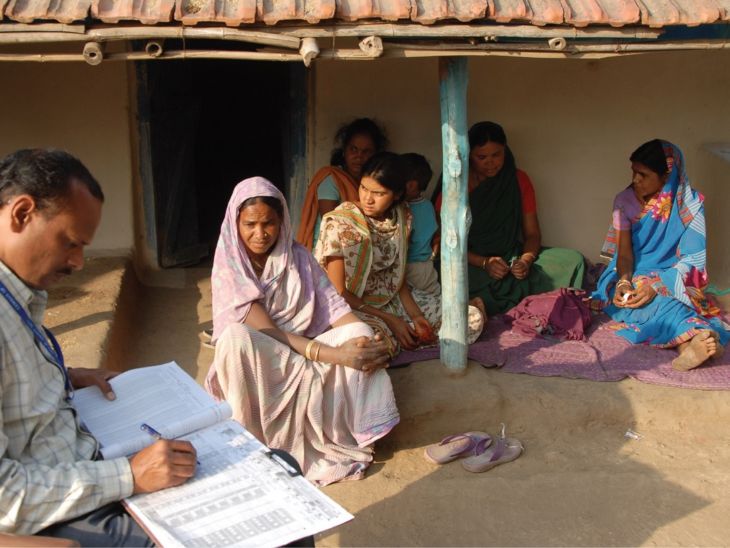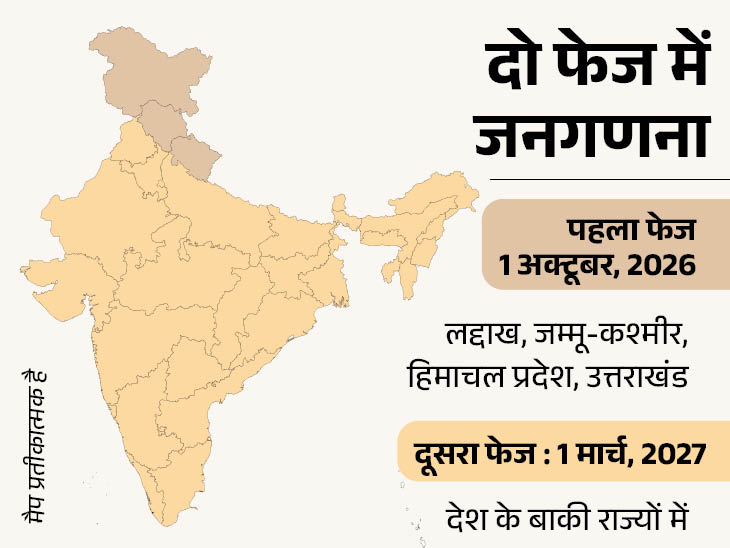New Delhi2 minutes ago
- Copy link

The world’s largest administrative exercise will begin the mockdrill from October 1 to investigate the entire mechanism before the start of Census-2027. Sources said that the mock drill will run 60 days. During this time, all the activities of the census will be tested.
The actual census will be started from 1 April 2026 by removing the flaws in 6 months on the basis of experiences. Census workers in Mockdrill will practice testing the entire machinery and work on it.
Smart map, house listing methods, data collections, real time data transfer, door-to-door location tracking, every household will get live pin and its latitude and longitude GPS will be investigated.
The biggest investigation in house listing will be digital layout mapping. Under this, there will be geo tagging of houses and all establishments. Counting workers will reach home and turn on the location in the app. Pin it on the map. In this way, geo tagging of the house or establishment will be done. Every village, town and every house in the city, shops, shrines, hotels and other buildings will become a GPS map by becoming a dot.

Every house will be made ‘Digi Dot’ on the map, it will have 5 benefits
1. Exact relief in disaster Digital layout map made of geo tagging will prove useful at the time of cloudburst, floods or an earthquake. At the time of an incident like cloudburst in a village situated in the remote Himalayan region, this map will immediately know how many people live. How many people must have been in hotels according to capacity. All the boats, helicopters, food packets etc. required to protect against this details will help.
2. delimitation will help It will also help in determining political boundaries such as parliamentary or assembly constituencies in a rational manner. This picture will be clear from the map prepared from geo tagging that how the balanced sharing of rural and urban areas in the area. Communities should not be divided in such a way that one mohalla joins one area and the other in another area. The process of delivery will be ease with the digi dot of homes.
3. Ease of urban planning This map will also prove useful in planning roads, schools, hospitals or parks in cities. If there is a lot of children in the digital layout of some place houses, then a plan can be prepared to build parks and schools on priority. If there is a lot of raw houses or bad houses in a colony, then immediate mobile relief vans can be sent there during a medical emergency.
4. Urbanization and migration rate data will be available Digital map changes in the census to be held ten years after this census can be easily recorded. The rate of urbanization in different parts of the country and maping of areas of migration can be compared to accurately.
5. Duplicate names will be removed from the voter list The geo tagging with Aadhaar identification will be helpful in making the voter list accurate and strengthening. When the voter is digitally connected to a geographical place, the address of his original residence will also be revealed at the time of double registration.
The first phase will start from 1 April 2026, will be listing houses

About 34 lakh census and supervisors, about 1.3 lakh census workers will be deployed for the census.
2027 census will be done in two phases. India’s General Registrar and Census Commissioner Mrityunjay Kumar Narayan said that from April 1, 2026, the appointment of houses, appointment of supervisors and counting staff, work will be distributed. The census of the population will begin on 1 February 2027.
Administration boundaries will be freeze from 1 January 26 to March 2027
- According to the Public Office, the option of a suggestion will be available on the web portal. Data will be collected in 16 languages including Hindi, English through mobile apps.
- Special web portal will also be for house listing, housing census (HLO) and population census.
- The General Registrar of India has asked states and union territories to make changes in the boundaries of administrative units before 31 December. This will be considered the last.
- Administrative boundaries in all states will be freezed from 1 January 2026. That is, after this, the boundaries or names of state districts, blocks will not be able to change. The entire duration of the census i.e. by March 2027 will remain the same.
- 34 lakh counting personnel will be deployed. There will be three level training. National trainer, master trainers and field trainers will be installed.
Most of the census work will be paperless The census from mobile apps, portals and real time data transfer will be largely paperless. There will be AI -based intelligent character recognition tools to read the information written on paper. There will be no scope for a mistake in the arrangement of GPS tagging and pre-code dropdown menu. There will be a nationwide publicity to help the common people.
Gazette notification of census was released on 16 June The Ministry of Home Affairs has issued a notification for the census on Monday (June 16). The central government will make ethnic in two phases. According to the notification, the first phase will start from 1 October 2026. This includes 4 hill states- Himachal Pradesh, Uttarakhand, Jammu and Kashmir and Ladakh. The second phase will start from 1 March 2027. In this, census will start in the rest of the states of the country.
Ethnic census will be 9th for the 9th time in the country
A total of 8 times ethnic census has been done in the country. Between 1872 and 1931, 7 times in the British period and once in 2011 in independent India. However, the 2011 ethnic census figures were not made public.

Along with the announcement of ethnic census, the government has also started making the outline of its implementation. The central government does not want to repeat it this time in the 2011 ethnic census. Then the government had not already made any list of the castes, who kept on registering whatever caste it told. As a result, more than 46 lakh castes were recorded. Read full news …



